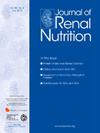A Survey on Nutrition Labeling for Sodium, Potassium, and Phosphorus of Packaged Food and Beverages
IF 3.2
3区 医学
Q2 NUTRITION & DIETETICS
引用次数: 0
Abstract
Objectives
Nutrition labeling is important to guide patients with chronic kidney disease to make informed choices. This study aimed to evaluate the extent and accessibility of nutrition labeling for sodium, potassium, and phosphorus on food and beverage products in a supermarket.
Methods
A cross-sectional survey was conducted in a Malaysian supermarket. Information on sodium, potassium, and phosphorus contents was collected from the nutrition fact panel, while information on food additives containing sodium, potassium, and phosphorus was collected from the ingredient list.
Results
The survey included 2,577 foods and beverages, and 79.4% of the products included sodium information in nutrition fact panels, but only 11.7% and 2.0% disclosed potassium and phosphorus content, respectively. Sodium-containing additives were found in 78.6% of products; potassium- and phosphorus-containing additives were reported in 28.5% and 46.9% of products, respectively. Sodium-containing additives were typically listed as “salt,” potassium-containing additives as “alternative names,” and phosphorus-containing additives as “starch” and “E numbers.” Imported products were more likely to include sodium (P < .001) and phosphorus (p = .036) contents, while more locally manufactured products reported sodium- (p = .003) and phosphorus- (P = .004) containing additives.
Conclusion
There is limited availability of potassium and phosphorus information on nutrition labels in Malaysia food and beverage products, which presents significant challenges for individuals with chronic kidney disease in choosing appropriate products for their dietary needs.
关于包装食品和饮料中钠、钾和磷营养标签的市场调查。
目的:营养标签对于指导慢性肾脏病(CKD)患者做出知情选择非常重要。本研究旨在评估超市食品和饮料中钠、钾和磷营养标签的范围和可获得性:方法:在一家[为盲审而删减]超市进行了一项横断面调查。钠、钾和磷含量信息从营养成分表中收集,含钠、钾和磷的食品添加剂信息从配料表中收集:调查包括 2,577 种食品和饮料,其中 79.4% 的产品在营养成分表中列出了钠的信息,但只有 11.7% 和 2.0% 的产品分别公布了钾和磷的含量。78.6%的产品中含有钠添加剂,28.5%的产品中含有钾添加剂,46.9%的产品中含有磷添加剂。含钠添加剂通常被列为 "盐",含钾添加剂被列为 "替代名称",含磷添加剂被列为 "淀粉 "和 "E 编号"。进口产品更有可能含有钠(p 结论:盲审删减]食品和饮料营养标签上的钾和磷信息有限,这给慢性肾脏病患者选择适合其饮食需求的产品带来了巨大挑战。
本文章由计算机程序翻译,如有差异,请以英文原文为准。
求助全文
约1分钟内获得全文
求助全文
来源期刊

Journal of Renal Nutrition
医学-泌尿学与肾脏学
CiteScore
5.70
自引率
12.50%
发文量
146
审稿时长
6.7 weeks
期刊介绍:
The Journal of Renal Nutrition is devoted exclusively to renal nutrition science and renal dietetics. Its content is appropriate for nutritionists, physicians and researchers working in nephrology. Each issue contains a state-of-the-art review, original research, articles on the clinical management and education of patients, a current literature review, and nutritional analysis of food products that have clinical relevance.
 求助内容:
求助内容: 应助结果提醒方式:
应助结果提醒方式:


